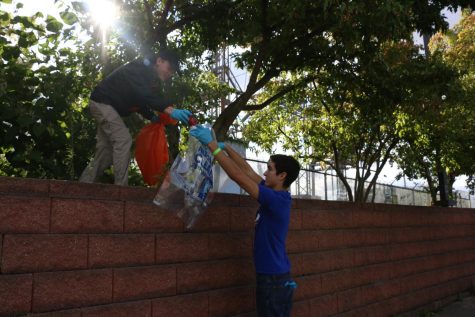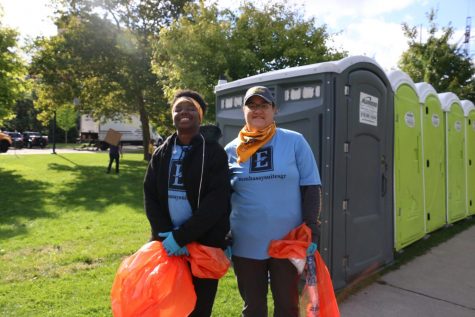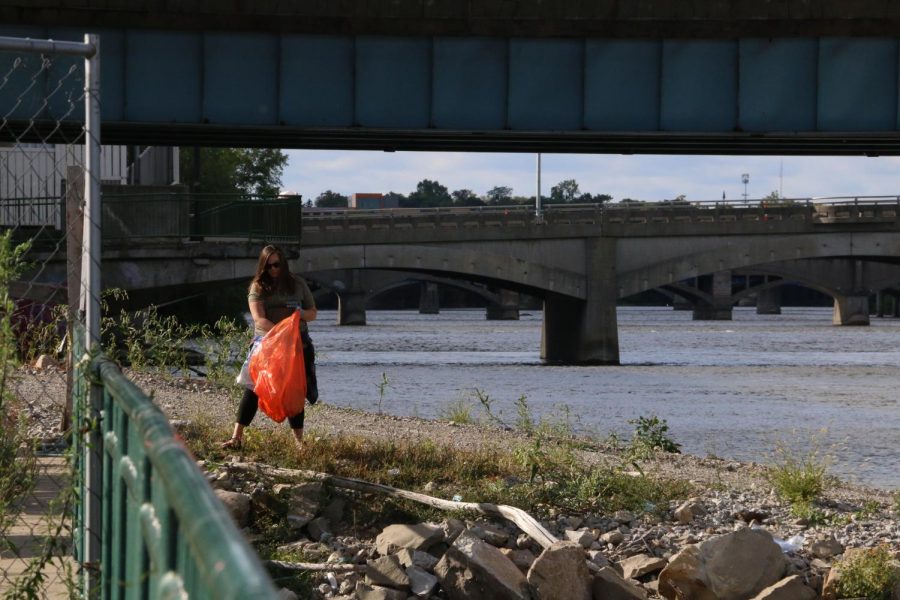WMEAC, volunteers clean Grand River across Grand Rapids
Sep 16, 2019

Those driving through Northland Drive Sept. 14 likely noticed people collecting objects along the road. This activity occurred as part of the annual Mayors’ Grand River Cleanup.
“I like to think of it as like we weren’t in the river, but we were in the watershed,” Calvin University student Bethany Williams said.
Williams explained she participates in an organization of sustainable coordinators at Calvin University. This group pursues learning to live sustainably as students. Williams recalled her interest to learn more about Grand Rapids, including the city’s efforts toward a greener future.
After cleaning along Northland Drive, Williams noted the experience differed from visiting Plaster Creek last year, for the creek helped volunteers to better understand waterways. By contrast, Northland Drive is not directly on the water. Instead, the road passes by Versluis Lake, which is south of the Grand River.
West Michigan Environmental Action Council (WMEAC) Executive Director Bill Wood described the Grand River as the longest river in the state that drains into Lake Michigan. He said that while many people think Grand Rapids uses the river for drinking water, the city actually utilizes Lake Michigan as the drinking source. Wood mentioned the city has separate sewage and storm drainage systems.
However, anything that enters the gutters of storm sewers enters the river and eventually Lake Michigan. He emphasized cleaning the storm basins provides two benefits. Aside from keeping pollutants out of the Grand River, the cleanup enables basins to flow freely without getting clogged by trash. The free flow of water reduces flooding in neighborhoods, Wood said.
Furthermore, Wood said the Mayors’ Grand River Cleanup was originally the Mayor’s Grand River Cleanup. The first year of the cleanup initially involved only Grand Rapids, but WMEAC later realized other communities have important roles to play in the endeavor. With other West Michigan mayors involved, the event’s name changed to plural.
“The water doesn’t really know any political boundaries or… city boundaries,” Wood said.

He described his hope that cooperation between mayors on an environmental goal depoliticizes clean water. Additionally, Wood said it is important for constituents to see their mayors participate in the cleanup to the extent of getting dirty. For Wood, this can bridge the gap between voters and city leaders.
Nonetheless, WMEAC and mayors are only one part of the Grand River cleanup. Volunteers from across west Michigan contribute a couple hours to picking up trash. Wood applauded this length of service, noting it is difficult to mobilize various individuals to clean all day.
As a result, the cleanup began at 9 a.m. after volunteers registered for the event. Following an address by city mayors, the volunteers boarded Grand Rapids Public School buses to sites throughout the city. For at least a couple hours, participants collected trash in orange bags and recyclables in clear bags. Upon returning from cleanup, volunteers enjoyed lunch at the Sixth Street Park.
Williams said she enjoyed getting to know her group better. Though they originally planned on attending a different location, school buses became packed with volunteers. Fortunately, her group proved flexible by boarding a new bus.
With various individuals involved with the cleanup, Wood explained WMEAC dealt with various logistical challenges. To better keep track of volunteers, the organization utilized Eventbrite, enabling volunteers to register online and print tickets.
Safety was another matter for WMEAC, so Wood mentioned a staff member designed an interactive map for the Grand River cleanup.

Wood mentioned a number of benefits for people who volunteered at the Mayors’ Grand River Cleanup. Anyone interested in being site leaders, for example, learned to manage small teams. He even identified selectability as a leadership skill, for site leaders could be confronted by water levels that make it infeasible to pick trash at sites. Even for people who do not serve as site leaders, Wood noted the cleanup can benefit them.
“If they’re just a volunteer for the day, I hope that they see that the power of all these folks coming together to do this work can have a meaningful impact,” Wood said.
























